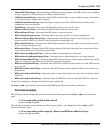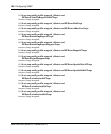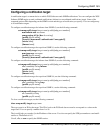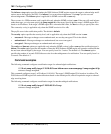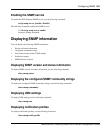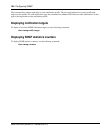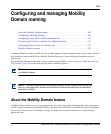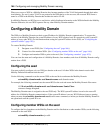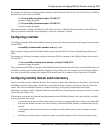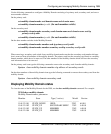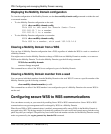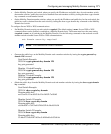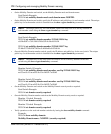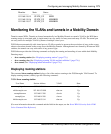
Configuring and managing Mobility Domain roaming 167
Nortel WLAN—Security Switch 2300 Series Configuration Guide
For example, the following commands add two members with IP addresses 192.168.12.7 and 192.168.15.5 to a Mobility
Domain whose seed is the current WSS:
WSS# set mobility-domain member 192.168.12.7
success: change accepted.
WSS# set mobility-domain member 192.168.15.5
success: change accepted.
Each command adds a member identified by its IP address to the list of Mobility Domain members. If the WSS from
which you enter the command is not configured as a seed, the command is rejected.
Configuring a member
To configure a member WSS in the Mobility Domain, you enter the following command when logged in to the nonseed
member WSS:
set mobility-domain mode member seed-ip ip-addr
This command configures the IP destination address that the member WSS uses when communicating with the seed
WSS.
For example, the following command configures the current WSS as a member of the Mobility Domain whose seed is
192.168.253.6:
WSS# set mobility-domain mode member seed-ip 192.168.253.6
success: change accepted.
This command sets the WSS as a member of the Mobility Domain defined on the seed device at the identified address. If
the WSS is currently part of another Mobility Domain or using another seed, this command overwrites that configura-
tion. After you enter this command, the member WSS obtains a new list of members from its new seed’s IP address.
Configuring mobility domain seed redundancy
Specify a secondary seed in a Mobility Domain. The secondary seed provides redundancy for the primary seed switch in
the Mobility Domain. If the primary seed becomes unavailable, then the secondary seed assumes the role of the seed
switch. This allows the Mobility Domain to continue functioning, if the primary seed becomes unavailable.
Specifying a secondary seed for a Mobility Domain is useful. Because, it eliminates the single point of failure, if connec-
tivity to the seed switch is lost.
If the primary seed switch fails, then the remaining members form a Mobility Domain. Also, the secondary seed takes
over as the primary seed switch.
• If countermeasures were in effect on the primary seed, they are stopped while the secondary seed gathers RF
data from the member switches. Once the secondary seed rebuilds the RF database, countermeasures can be
restored.
• VLAN tunnels (other than those between the member switches and the primary seed) continues to operate
normally.
• Roaming and session statistics continues to gather, provided the primary seed is uninvolved with roaming.



